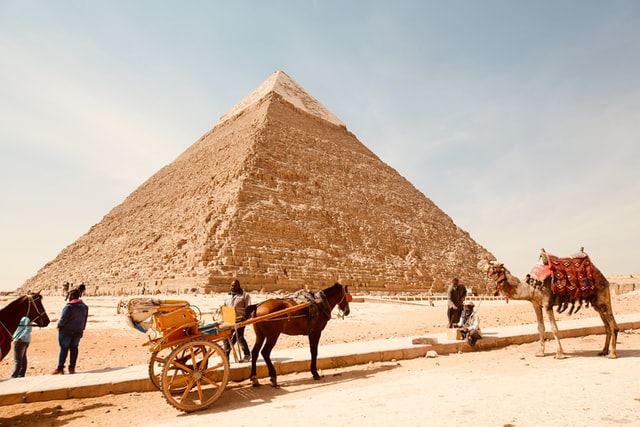The Great Pyramid of Giza stands as a testament to the ingenuity and ambition of ancient Egypt. This monumental structure, built during the reign of Pharaoh Khufu, has fascinated historians, archaeologists, and tourists alike for centuries. Let’s dive deeper into the facts, history, and mysteries surrounding this iconic landmark.
A Brief Overview of the Great Pyramid
- Location: The Great Pyramid is situated on the Giza Plateau, just outside Cairo, Egypt.
- Construction Timeline: It was constructed over a 20-year period during the Fourth Dynasty of the Old Kingdom, specifically from 2589 to 2566 BCE.
- Dimensions: Originally standing at 146.5 meters (481 feet), it was the tallest man-made structure in the world for over 3,800 years. Today, due to the loss of the outer casing stones, its height is approximately 138.8 meters (455 feet).
- Structure: The pyramid is part of a complex that includes two other major pyramids—those of Khafre and Menkaure—and several smaller pyramids built for Khufu’s queens.
The Historical Significance of the Great Pyramid
The Great Pyramid of Giza is not just a tomb; it is a symbol of the power and religious beliefs of ancient Egypt.
Pharaoh Khufu: The Visionary Behind the Pyramid
Khufu, also known as Cheops, was the second pharaoh of the Fourth Dynasty. His vision for the pyramid was grand, aiming to ensure his legacy and secure his place in the afterlife.
The pyramid served as his final resting place, a monumental structure designed to help him ascend to the heavens.
Architectural Marvel of the Ancient World
The construction of the Great Pyramid is considered one of the greatest architectural feats of all time.
- Materials Used: It is estimated that around 2.3 million blocks of limestone were used, sourced primarily from local quarries. The heavier granite stones used in the interior chambers were transported from Aswan, located about 800 kilometers (497 miles) away.
- Construction Techniques: Despite the absence of modern machinery, the ancient Egyptians utilized simple yet effective tools and techniques. Theories suggest that they may have employed a system of ramps and levers to move the massive stones into place.
- Precision Engineering: The pyramid’s base is remarkably level, with only a 2.1 cm (less than an inch) variation across its sides. The alignment of the pyramid is so precise that the difference in length among its four sides is just 4.4 cm (1¾ inches).
Exploring the Exterior of the Great Pyramid
The exterior of the Great Pyramid is as fascinating as its interior.
The Outer Casing
Originally, the pyramid was encased in smooth, white Tura limestone, which reflected sunlight and made it shine brightly. However, many of these casing stones were removed over the centuries for use in other buildings, including mosques in Cairo.
The Giza Complex
The Great Pyramid is part of the Giza Necropolis, which includes:
- Pyramid of Khafre: Slightly smaller than Khufu’s pyramid, it appears taller due to its elevated location.
- Pyramid of Menkaure: The smallest of the three, it stands at 65 meters (213 feet).
- Queen’s Pyramids: Three smaller pyramids dedicated to Khufu’s queens are also part of the complex.
Inside the Great Pyramid: A Journey Through Time
Entering the Great Pyramid is like stepping into a time capsule, revealing the architectural brilliance of ancient Egyptians.
The Grand Gallery
Upon entering, visitors are greeted by the Grand Gallery, a remarkable passage that rises to a height of 8.74 meters (26 feet). This corridor leads to the King’s Chamber, where Khufu’s sarcophagus lies.
The King’s Chamber
- Construction: The King’s Chamber is constructed entirely from red granite, showcasing the Egyptians’ mastery of stonework.
- Sarcophagus: The sarcophagus, which remains empty, is positioned at the center of the chamber, surrounded by massive granite blocks that support the structure above.
Mysterious Features
The pyramid also contains several intriguing features:
- Ventilation Shafts: These ducts extend from the upper chambers and have puzzled researchers for years regarding their purpose.
- Underground Chamber: An unfinished underground chamber adds to the mystery, with its purpose still debated among scholars.
Visiting the Great Pyramid: What You Need to Know
If you’re planning a visit to this ancient wonder, here are some essential tips:
Ticket Information
- Entry Fees: There is a general admission fee to enter the Giza Plateau, with additional charges for accessing the individual pyramids.
- Guided Tours: Opting for a guided tour can enhance your experience, providing insights into the history and significance of the pyramids while handling all the logistics.
Best Time to Visit
- Seasonal Considerations: The best time to visit is during the cooler months, from October to April, to avoid the scorching heat of the Egyptian summer.
- Timing Your Visit: Early morning or late afternoon visits can help you avoid crowds and offer stunning views of the pyramids against the backdrop of the setting sun.
The Legacy of the Great Pyramid
The Great Pyramid of Giza continues to captivate the imagination of people around the world.
- Cultural Impact: It has inspired countless works of art, literature, and film, symbolizing the mysteries of ancient civilizations.
- Modern Research: Ongoing archaeological studies and technological advancements, such as the use of drones and 3D scanning, are continually revealing new insights into its construction and history.
Conclusion: A Timeless Wonder
The Great Pyramid of Giza is more than just a tomb; it is a symbol of human achievement and a window into the past. Its grandeur and mystery continue to draw millions of visitors each year, reminding us of the incredible capabilities of ancient civilizations.
As we explore its depths and marvel at its height, we are left with a profound appreciation for the ingenuity that shaped our world.
Whether you are a history buff, an architecture enthusiast, or simply a curious traveler, the Great Pyramid of Giza promises an unforgettable experience that transcends time and space. For more fascinating insights into the wonders of the ancient world, stay tuned for our upcoming articles!
